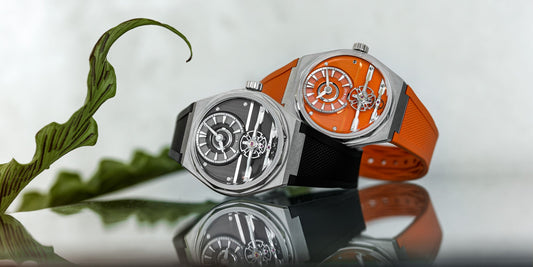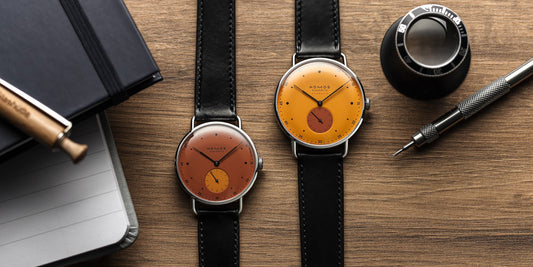A very brief history of the Chronograph
Chronographs – sometimes referred to as chronoscopes - have been around since 1816, when French watchmaker, Louis Moinet released the first chronograph (inside a pocket-watch casing) to the world. Fast forward, over a century later to 1934, when Breitling patented the first chronograph, as we know it (with 2 ‘pushers’, with one of each aside the crown). Arguably, Longines developed a ‘mono-pusher’ chronograph (of-sorts) in 1913, but that’s for another blog.
So, how do we define a Chronograph?
A chronograph is a watch with an added ‘complication’ that allows for additional timing, or to put it simply, it’s basically a stop-watch within a watch that displays such measurements on a dial with uo to three sub-dials. So, in essence it tells the current time as well as using a separate, mechanical function to track time for, say, a sporting trial. Some complications allow for tracking more than one event (using a ‘stop/start/elapsed-time’ function) and therefore the complications can be simple or, well, complicated.
So, when I was given the challenge to choose my Top 5 Chronographs for under £2000 I thought this would be a relatively simple task – and was I wrong?!
Instantly, a dozen or so chronographs came to mind – but many came in beyond the £2k maximum and/or were no longer for sale (as new/current/readily available) – and then there were a load that came way in at the lower end of the pricing scale – which of course is fine – and there are plenty of these – too plentiful now in fact, which made choosing just 5 quite difficult. There are so many decent chronographs under £2000 – we’re spoilt for choice in fact.
I’ve personally had a fluctuating love/hate relationship with chronographs since I started showing an interest in horology, often viewing them as unnecessarily complicated, too big and/or cluttering the face with too many sub-dials. Take for example two classic, high-end chronographs: the Breitling Navitimer – it’s awash with dial markings (timing bezels, tachymeter, chronograph, day/date) and for me personally it’s a bit too much in your face (pun intentional). And then there is the Omega Speedmaster; originally released in 1957, and now in numerous sizes, handwound/automatic, Hesalite (acrylic)/sapphire crystal, different dial colours and configurations – Omega, even now, have a multitude of choice – despite this I and many do love the Speedmaster and view it as an icon amongst the watch world, not just because it’s heralded as being the first watch to be worn on the moon, but because (in my eyes, at least) it looks so classically cool anyway.
 Omega Speedmaster - Credit WatchGecko
Omega Speedmaster - Credit WatchGecko
It’s biggest rival was the Rolex Daytona, a watch that has been made famous by the likes of acting/motorsport legend, Paul Newman – but here we are talking very silly money now, brand new (if you can even get hold of one) or on the used-market.
But I digress – none of these aforementioned fit in to the sub £2k budget, so they’re out of the question anyway but they have always been an influence, almost like a mentor, for other slightly more affordable pieces to take inspiration from. So, here are 5 current, and slightly more affordable, chronographs that I’d recommend – and listing just 5 was not easy (maybe a follow-on at some stage to list the next top 5 may be in the offing).
Those below are currently acquirable timepieces that vary in price-range, spec and features - and here are some clues before reading on: one is automatic; two are hand-wound; two are high-accuracy quartz (one of which is also solar-powered) .. so here goes:
-
Citizen Red Arrows Skyhawk A.T
Citizen is a huge player in the watch market, offering many chronographs at numerous price-points, so it was difficult to chose just one from their wide selection. This limited edition RAF Red Arrows special is now an icon, albeit at the higher end of the Citizen price-range - but just look what it delivers: tachymeter, alarm, perpetual calendar, stop-watch (obviously), solar powered, alternative time zone monitoring (in 43 countries!), 200m water-resistance and being radio-controlled (atomic-clock) for up to the minute accurate time-keeping, this represents amazing value. It’s a big beast at 46mm, but to house all that information, and arguably it’s a very busy dial, it kind of has to be. Perfect for any aspiring Red Arrows pilot, this surely has to feature in the top 5: it’s reliable, full of tech, tough, accurate and, despite being a quartz, never needs a replacement battery. The ultimate tool-chronograph?
-
Farer Carnegie-Sport
 Farer Carnegie-Sport - Credit Farer
Farer Carnegie-Sport - Credit Farer
This, is the most expensive of the 5 watches shortlisted here. Admittedly, I am somewhat a slightly biased fan of this British based/Swiss made microbrand but finding a brand new, quality Swiss automatic chronograph for under £2000 isn’t quite as easy as I was expecting – but in the Farer Carnegie-Sport they have delivered something special, and a bit different (as Farer often do) from the mainstream designs offered elsewhere. Farer manages to please their fans, and new customers alike, with quality made watches and with a dash of stylish diversity, often using bright colours. That said, the Carnegie is more muted than some of the other models in Farer’s range. This chronograph uses the Swiss made, hand-wound Sellita SW510M movement, in Elaboré grade, encompassed by a Grade 2 titanium casing, bronze-cap to the crown and a ceramic bezel. A Swiss-made chronograph, and in titanium, for under £2000, is a good find, and being produced in limited numbers it’ll also hold its value well over the many years of ownership.
 Farer Carnegie-Sport - Credit Farer
Farer Carnegie-Sport - Credit Farer
-
Seagull 1963
 Seagull1963 - Credit Guest Author
Seagull1963 - Credit Guest Author
This very popular military chronograph is celebrating it’s 60th anniversary this year, and with a limited run of 750 pieces cast in bronze to celebrate this milestone, it has to be on the shortlist. There are countless alternative variants to choose from, across numerous affiliated (and not so affiliated) manufacturers who have the rights (or not) to this very popular, military-inspired timepiece. Originally developed for the Chinese Airforce in 1963, this is one of the most affordable (and cloned) mechanical chronographs out there. It utilises the ever-popular and often decorated Seagull ST1901 hand-wound movement, which is mesmerizingly stunning to watch (pun intended). It comes in numerous sizes, with 38mm being the most popular, differing dial colours, strap options and with either a sapphire or acrylic crystal, the latter of which is often seen to be the most authentically apt crystal finish. An iconic, mechanical chronograph for less than £300? - this has to be the bargain pick of the bunch?
 Tissot PRX Chronograph - Credit Tissot
Tissot PRX Chronograph - Credit Tissot
When the retro-styled, re-boot of the PRX (3 hander) was re-released in 2021, it took the watch world by storm - and demand for these ceases to wain. Often sold out fast, between re-stocks and second-hand prices going silly in the flipper-market, supply has now started to keep up with demand, so it’s quite easy to get hold of one. Every now and again, Tissot kindly sates eagerly excited fans for a new offering, be it in a new size or dial colour and in 2022 the chronograph automatic variant was released to rapturous demand – and what a stunner it is! Maintaining the same 70s’ PRX style casing, with classically styled integrated bracelet, the chrono oozes even more coolness with the 3 additional dials, utilising the amazing Valjoux A05.H31 automatic calibre (with 60 hour power-reserve) , whilst not upsetting the overall aesthetics of its slightly smaller, 3-hander brethren. For under £2000 (and with spare change to buy an aforementioned Seagull 1963 as well) the PRX chronograph offers great value for a high-end, great quality, Swiss-made timepiece.
- Bulova Lunar Pilot
 Bulova Lunar Pilot - Credit Bulova
Bulova Lunar Pilot - Credit Bulova
Many watch fans will be aware of this more affordable ‘moon watch’ that was released in 2016 to commemorate the Bulova worn by NASA astronaut, Dave Scott, during his flight aboard Apollo 15 in 1971, as his (alleged) back-up for his Omega Speedmaster. The backstory is intriguing, and you can find out more here: https://www.watchgecko.com/blogs/magazine/battle-of-the-moonwatches
 Bulova Lunar Pilot - Credit WatchGecko
Bulova Lunar Pilot - Credit WatchGecko
Bulova have chosen a superbly reliable and extremely accurate quartz movement that ticks at 262Hz; the original reproduction model was a rather dominant 45mm of heavy all bead-blasted chunkiness with a date window at 4, available on a non-tapering, 20mm carbon-fibre effect leather strap, along with a NASA style NATO/Velcro and presented nicely alongside an interesting information booklet and certificate of authenticity. Then followed a slightly less expensive second variant that aptly used the original Bulova font on the dial as per the era, with an all-polished case on black NATO (only); followed soon after by the same albeit in a DLC, matt black finish and then a limited run of a gold and grey dial variant. Most recently, a (slightly) slimmed down version (43.5mm) was added, the size of which is understood to be more akin to the one Scott wore, and is presented in both the original black (with original logo) or as a stunning cream/blue finish with an almost lunar-like textured surface/finish on the dial. If your budget doesn’t stretch to an Omega Speedmaster Moon Watch, then the Bulova is quite possibly the next best thing anyway - and quite probably less common too.















